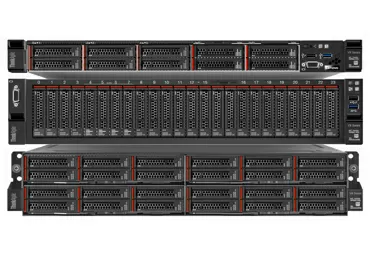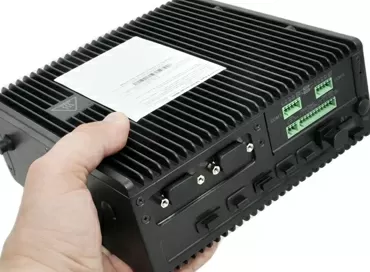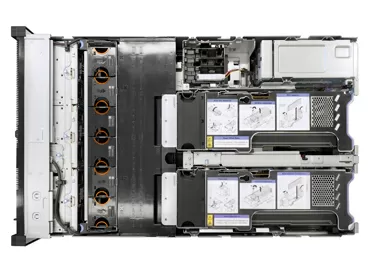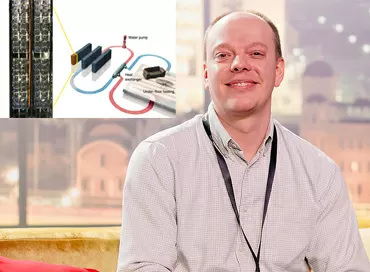Lenovo Thinkserver SE350 Edge server review: a peripheral hero!
Today we are considering a new class of devices, and I am unspeakably happy that over the decades of development of the server industry, for the first time I have been holding something new in my hands. This is not "old in new packaging", this is a clean slate device that has almost nothing to do with its predecessors, and this is an Edge server from Lenovo. If you are still lost in the terminology, and do not know what "Edge" is, then in short the evolution developed in this way:
- At first, large companies decided that Big Data would help them improve their efficiency, from mining ore to selling gum at the supermarket checkout.
- Then they decided that if every sensor in production, every camera and every switch is connected to a common network, the telemetry received can become part of Big Data and help prevent theft in the store, breakdown of the drilling rig or control the temperature in the oven in advance. So modern enterprises have acquired myriads of IoT devices, sensors, triggers, meters, switches, and so on and so forth.

- The further the IoT park spread "to the periphery", penetrated into small towns, villages, forests and swamps, mines and wells, the clearer it became that you would not bring high-speed Internet to each object, and transfer all data in real time in the main data center will not become. Somewhere there is no Internet at all, except for 3G/4G mobile communications.
- At that moment, it became clear that most of the telemetry from IoT devices, and indeed a lot of calculations can be processed locally at the facility, and either already prepared and structured data or reports on their processing can be sent to the main data center of the company. The easiest way here is to draw an analogy with video surveillance systems: why do you need to transfer the entire stream from the camera to the data center, when you can send either photographs of moving objects or, in general, reports with photographs created using face recognition templates. This approach allows in many ways to move away from systems operating in real time and allows periodic data exchange, for example, once every few minutes. This is the concept of "edge computing", the very Edge, which is predicted a great future. In our native language, it is customary to say “on the ground,” or “on the periphery,” that is, away from the beautiful glass offices, and closer to the people.
And now it turned out that ordinary servers are unsuitable for work "on the periphery": they are very expensive, too delicate, easily overheat, make a lot of noise, take up a lot of space and carry such a bunch of problems with them that it is easier to use powerful laptops for computing .
|
Test configuration |
Lenovo ThinkServer SE350 |
|
Processor | |
|
Memory |
1x DDR4 ECC RDIMM 16 Gb, 2666 MHz |
|
Storage |
2x SSD SATA600 M.2 480Gb |
|
Network ports |
2x SFP + 10G 2x SFP + 1G 2x 1GBase-T 1x 1GBase-T for management |
|
USB ports |
2x USB 3.1 front 2x USB 2.0 back Mini USB for smartphone |
|
Wi-Fi |
802.11ac |
| LTE |
LTE 4G |
|
Operating systems |
Windows Server 2019 VMware ESXi 6.7U3 |
Naturally, the industry has responded to the challenge of our time by introducing a new class of devices: a server for any road, compact, robust, vandal-proof, secure ... you feel ... none of the above properties are applicable to old servers! Meet Lenovo ThinkServer SE350.
Form Factor
Edge servers do not have a single case format: in the carpentry shop you hang it on the wall, and in the inflatable tent only on the table, so Lenovo has made its ThinkServer SE350 as compact as possible. It is 1U (40mm) high, 0.5U (215mm) wide, and 376mm long.
It can be said that this server is 1/2U in size and can be easily carried around like a laptop, but it is not. We forgot about the power supplies, of which there are as many as two, and both are external, rather large, with a capacity of 240 W each. With such luggage, the entire compactness of the car can be safely divided into two, because it needs two places on the wall, you put the server on the table - power supplies under the table, and so on. Of course, it is allowed to install two machines in 1 unit or in 2 units of a server cabinet, but this option is considered as an exception, and sleds for such an installation are purchased separately.
By default, the manufacturer suggests using the server and power supplies to be mounted on the wall, for which the machine is equipped with powerful steel brackets. Considering that `` on the periphery '' the site may not even have a simple network switch, and the Thinkserver SE350 itself acts as a Wi-Fi hotspot, hanging it higher is a good idea. Well, just do not forget that two power supplies will hang on the bracket nearby. By the way, their manufacturer is FSP, and with all due respect to this company, this supplier is not the best choice for an Enterprise device, I would prefer to see Delta or Seasonic power supplies.
According to the test results, FSP power supplies show good efficiency for an external adapter. I recommend connecting one of the power supplies to a non-redundant UPS outlet, or to the one that shuts down on a timer to extend the battery life of the server. A typical 2KVA UPS will provide approximately 3 hours of server battery life. So even if the generator runs out of diesel, you will have time to go to the gas station.
Anti-theft protection
To prevent a bystander or his own worker from removing and taking the server home, the bracket has a Kensington lock with a powerful anti-burglary bolt that locks the machine in the bracket. Removing the ThinkServer SE350 from the wall without having a key is only possible with a crowbar, pulling out the bracket along with the dowels.
But if you are afraid that, having stolen your server, an attacker will sell it to Avito, then do not worry: Lenovo ThinkServer SE350 also has electronic protection against theft, like modern smartphones and laptops. Upon purchase, you activate the server on the Lenovo portal using the QR code on its body, model and serial number. By linking the car to your account, you simply enable protection in the BIOS and activate the built-in sensors. There are only two of them: the first is the familiar to us sensor for opening the lid, which, by the way, cannot be opened without removing the bracket, and the second is a position sensor that records, for example, that the machine was hanging in a vertical position, and now it is horizontal.
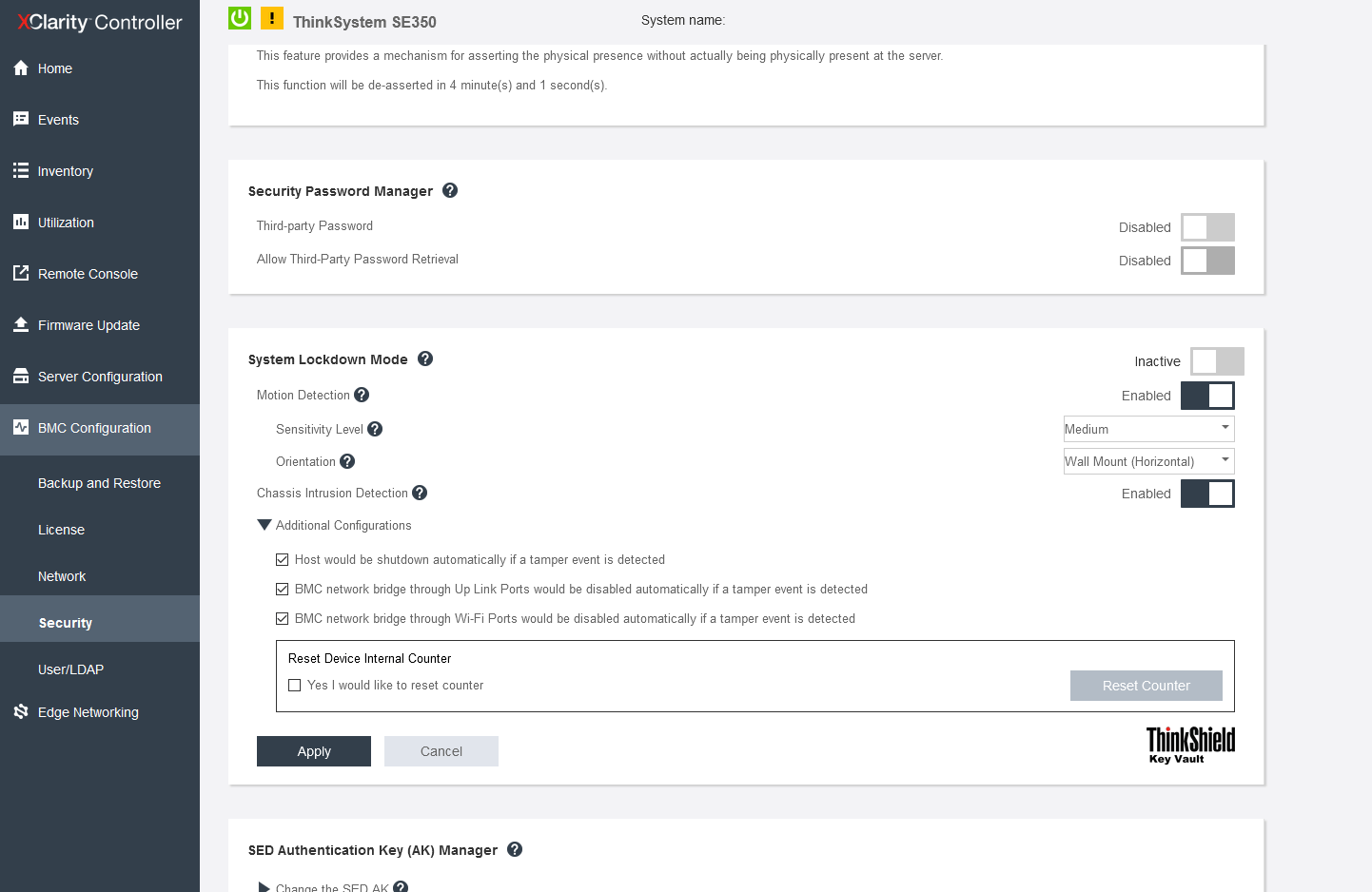
As soon as the server realizes that they tried to steal it, it will not only be blocked, but also "put out" its network interfaces, including Wi-Fi, LTE and wired, and it can be returned to work only through the reactivation procedure in the Lenovo cloud service, using a smartphone connection or remotely. To prevent the system from giving false alarms in seismically active areas, the sensitivity and position in space are configured from the BIOS. Thus, theft for the purpose of resale makes no sense, and attackers will not carry out a MITM attack by placing the server in its own network environment. When using SEDs, the deletion of encryption keys is also configured, but since in many countries these devices are prohibited for import, we bypass this function, and we remind readers that these technologies protect only the platform itself, and refuse to use Bitlocker, Truecrypt or other means encryption is not worth it.
Of course, if I were the manufacturer, I would put a large sticker in the server package with the words “the computer is encrypted” or “anti-theft installed”, because an attacker does not know that it is useless to steal ThinkServer SE350: you will get nothing but problems.
Dust protection
There is fine dust even in the most expensive data centers, and even in production or in the field of this good in bulk, but Lenovo has protection in the form of foam filters installed on frames under the front bezel. The first filter covers the main air intake through which the processor is blown, and the second covers the expansion board.
In addition, every port and every external socket on the server has a tight rubber plug. I have never met a cover for Mini-USB, or RJ45 before, and here even the antenna jack and even the hole for the antenna jack have their own cap. In general, you do not have to worry that the server will swallow sand or dust and start to freeze. Cool, Lenovo, well done!
Wireless communications
There are three versions of Thinkserver SE350 with different network port configurations shown in the diagram below. We have at our disposal a top-end one with:
- 2 SFP + slots 10 Gbps,
- 2 SFP slots for 1 Gbps,
- 1 RJ45 for BMC
- 2 RJ45 1 Gbps
The main network controller here is Intel x722, providing 4 channels of 10 Gbps, two of which are routed to SFP + slots, one is not used, and the rest is connected to the Edgeboard, which is essentially a wireless router that works almost regardless of the server.
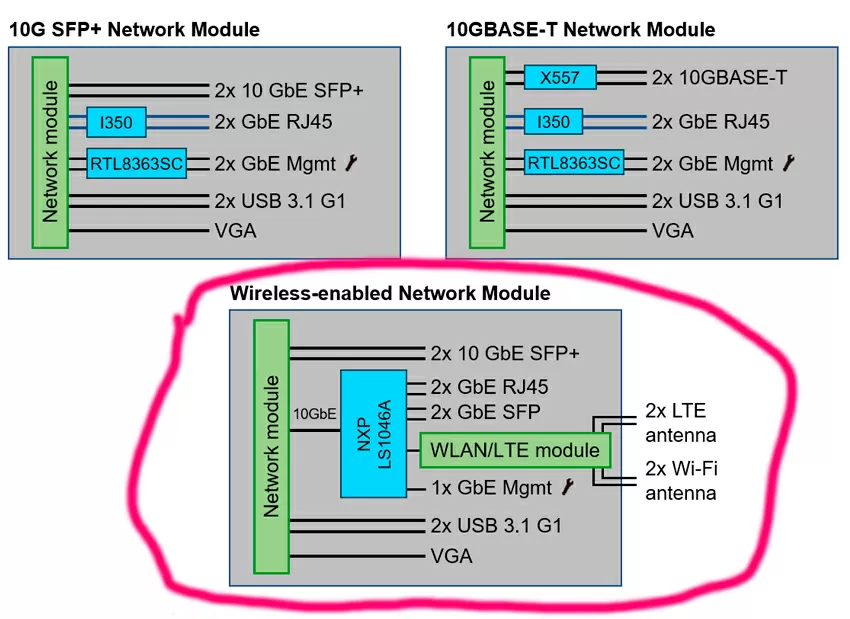
Physically, Edgeboard is a module that combines two Mini-PCIe cards and an NXP LS1046A switch. To install a Nano-SIM card, you will have to pull this module out of the server, disconnecting all antennas from it. You only have a slot for one SIM-card, which in the modern world of dual-SIM phones and WLAN-routers looks somewhat strange. The wireless module supports the 802.11ac standard with two spatial streams, which gives a maximum speed of 433 Mbps.
The switch is managed in hardware, through the BMC controller, XClarity Control. Here you can select the roles of ports 7, 5 and 6, as well as 8 and 9.
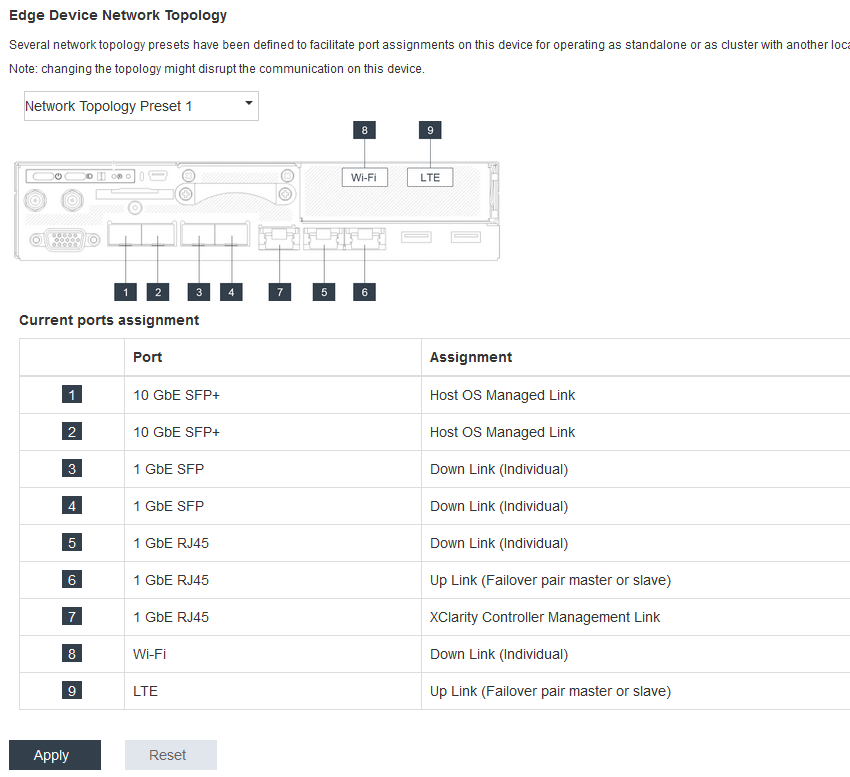
That is, in other words, in the operating system you always have 10-gigabit ports 1 and 2 available and never available Wi-Fi, LTE, ports 5, 6 and 7. Instead, you will have a virtual adapter with your own An IP address like 192.168.73.xx, through which the server receives and distributes the Internet. For example, on top there can be 10G from the provider + LTE, and from the bottom through gigabit RJ45 - the entire network infrastructure of the enterprise + Wi-Fi from the server access point. Interestingly, with this configuration, the server does not even notice the disappearance of the network on one of the ports. And yes, of course you can connect your smartphone as a USB modem if nothing else remains.
Why was Lenovo so smart, and it wouldn't be easier to install simple modems and Wi-Fi controlled from the OS? Perhaps the main thing is the independent operation of the Wi-Fi/LTE module from the server: it can overload, freeze, install updates, and devices connected to the EdgeBoard ports must be constantly connected to the Internet. Plus, you have additional hardware isolation of WAN from LAN and a built-in access point with a backup 4G channel. But, of course, the settings for the wireless module are minimal, and for the user its operation looks opaque, so from my point of view, this implementation of redundancy is very controversial.
Storage
We are happy to say goodbye to hard drives, sending even the 2.5-inch form factor into oblivion. Lenovo ThinkServer SE350 only supports non-hot plug M.2 drives. Logically, the storage system in the server is divided into boot drives (M.2 board behind the riser, not available in our package) and data drives (NVME or SATA600). By default, we have 4 M.2 NVME/SATA slots, occupied by two 480GB SATA drives.
Tests show that these are very fast server disks, which do not sag in speed during intensive writes, and have a predictable response time without blockages.
Additionally, you can install the same riser for 4 M.2 boards instead of an expansion card. When using SED-disks, you can purchase the function of automatic clearing of encryption keys when triggered by tamper sensors and anti-theft systems. Hardware RAID is available for the boot adapter, which installs the same drives in mirrored mode, and for storage drives, you can use Intel's standard software RAID. In total, this kid can contain 10 M.2 drives, which is very cool for a half of a single-unit case!
Extensibility
None of my colleagues have guessed why there is a wrench inside the server, but everything is simple: the server provides the ability to transfer Wi-Fi/LTE antennas from the back to the front panel. This is what the key is for. By default, the server ships with 1 16GB DDR4 2666MHz ECC Registered module and an empty low-profile PCI Express card slot. Supports memory modules up to 64 GB each with a frequency of 2133/2400/2666 MHz with a total volume of up to 256 GB.
When ordering, you can select a modification of the processor from the Xeon-D 2100 series. This is a very good CPU that we have already tested earlier, it is designed specifically for embedded systems such as security gateways, NAS and edge computing nodes. In our test system, we installed Xeon-D 2123, 4-core with a base frequency of 2.2 GHz, TurboBoost - 3.0 GHz, support for HyperThreading, AVX-2 and AVX-512.
In the server BIOS it is possible to set the type of power consumption OS Control mode to comply with VMware recommendations for using Turbo Boost inside a VM, as well as to limit the maximum Turbo Boost frequency. In our tests, the maximum turbo frequency of the processor did not exceed 2.68 GHz, and no matter how hard I tried, I could not bring its frequency to any higher even in 1-thread mode. From my own experience, I can say that for Xeon-D the number of memory channels involved is not so important as the frequency of installed modules. Plus, this is a very hot processor for its 60W, so don't panic if it heats up above 60 degrees with almost no load: the server cooling system has nothing to do with it.
... especially since here it is represented by three 40mm Delta Electronics fans with anti-vibration mounts and the ability to easily replace (Cold Swap). Automatic speed control allows them to operate over a very wide range from 3000 RPM to 24000 RPM. In idle mode at room temperature, the noise level is about 38 dB. I want to note once again that Lenovo ThinkServer SE350 has an extended operating temperature range of ambient air: up to +45 degrees Celsius in any configuration and up to +55 degrees in some.

The server has 1 low profile PCI Express 3.0 x16 expansion slot without additional power (75W limit). If you need to use AI and machine learning functions, you can install an Nvidia Tesla T4 16 Gb adapter, as well as other FPGA and ASIC boards.
Remote control and UEFI
The Lenovo ThinkServer SE350 uses its own XC Clarity remote control system on the Pilot4 XE401 controller. By the way, this management controller is used in all modern Lenovo servers. Basic functions such as unlocking or activating the car can be performed by connecting a smartphone via the microUSB port on the front panel. By the way, to the left of this port are hidden buttons for resetting the wireless controller (see above) and giving an NMI signal for a hardware reset.
Of course, the interface is very beautiful: there are graphs and diagrams for you, and excellent compatibility with mobile browsers. And UEFI looks the same, with the same mouse controls as BMC. Up to 6 users can work with one remote console window simultaneously, it is possible to mount virtual disks via the NFS protocol, set keyboard shortcut macros, etc. It is useless to list all the items, we look at the screenshots.
ДляFor simplified deployment, the BIOS has an option for accelerated installation of Windows Server 2016 or VMware ESXi 6.5/6.7: just enter your administrator password, and go have tea, the system will partition the disks and install the OS itself.
Warranty
Lenovo ThinkServer SE350 is backed by a 3-year warranty, renewable to 5 years. Solid-state drives are warranted if their rewrite cycles specified in the user manual have not expired. On-site service is available in 9x5 mode with next day check-out, as well as service improvement packages.
Recommendations when ordering
As you can see, Lenovo ThinkServer SE350 is too unusual to compare and contrast with analogs from other companies: a full-fledged Intel Xeon is installed here, with buffered ECC memory, a fast network even by modern standards, very good storage capabilities data and protection against theft. This is not the case when they just took a powerful nettop on Core i7 and hung them with antennas, called it a server for Edge.
At the very beginning of the article, I said that the word "Edge" usually implies the concept of "on the periphery", but this term has another concept. Yet, in the IT world, the term "Edge" most advanced technologies are commonly referred to, and in the case of the ThinkServer SE350, this translation should be considered correct. Some of the solutions used here are a curiosity for us, with something, for example, with the implementation of connections to Wi-Fi and LTE, we have to spend hours of rethinking, but as a result, this is a machine that has nothing of the kind, and ordering it through a tender, you can be sure that you will not get an analogue.
Mikhail Degtyarev (aka LIKE OFF)
05/03.2020









